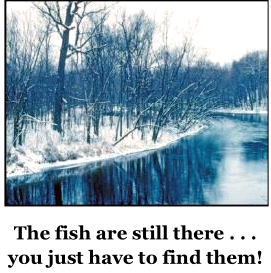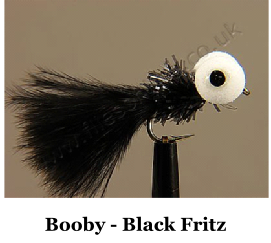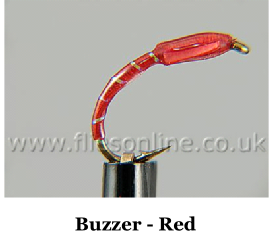WINTER
BACK TO TABLE OF CONTENTS
Without doubt, the hardest time to enjoy consistently successful fishing for trout is in the short, dark days of winter. Many fisheries simply close up shop for those cold months, but there is fishing to be had if you persevere and keep warm. It all depends on how committed - or crazy you are. I'm afraid I may fall into the latter category!
 The first tenet of winter fishing is to keep everything deep and slow. As always there is an exception which I will cover in due course. Fish have a built in cost/benefit analysis system that computes whether there is gain to be had in rousing themselves from their torpor to grab your offering. If you whizz your fly past their nose they are unlikely to respond - besides it will appear unnatural to them to see something so lively when everything else is in a state of near hibernation. They need time to decide and will not exert much effort - so a fly twitched slowly along the bottom is likely to produce the best results.
The first tenet of winter fishing is to keep everything deep and slow. As always there is an exception which I will cover in due course. Fish have a built in cost/benefit analysis system that computes whether there is gain to be had in rousing themselves from their torpor to grab your offering. If you whizz your fly past their nose they are unlikely to respond - besides it will appear unnatural to them to see something so lively when everything else is in a state of near hibernation. They need time to decide and will not exert much effort - so a fly twitched slowly along the bottom is likely to produce the best results.
What fly? One that won't get snagged up in the detritus that litters the bottom of all lakes and reservoirs. And that means one that will float above it or hover above it, depending on your fishing technique. Whichever it is, you need to be really close to the bottom of the water.
 The idea of hanging a fly in the depths is discussed in the section on summer fishing, so I will not repeat it here. The idea is the same - the fish will seek the deepest parts of the water to find the most comfortable conditions, only this time it is the warmest in winter rather than the coolest in summer. My personal opinion is that this is a less productive pastime as the deep sitting fish are likely to be in a state of torpor and are more likely to seek the shallows occasionally to feed. Besides, it is much more difficult to get your depth just right when fishing this system as slowly as needed. The fly and extended length of the leader is likely to start pulling the floating line down.
The idea of hanging a fly in the depths is discussed in the section on summer fishing, so I will not repeat it here. The idea is the same - the fish will seek the deepest parts of the water to find the most comfortable conditions, only this time it is the warmest in winter rather than the coolest in summer. My personal opinion is that this is a less productive pastime as the deep sitting fish are likely to be in a state of torpor and are more likely to seek the shallows occasionally to feed. Besides, it is much more difficult to get your depth just right when fishing this system as slowly as needed. The fly and extended length of the leader is likely to start pulling the floating line down.
 The most widely used example of a fly that will float is our ubiquitous booby, although I have had good successes on a razzler as well (see the Flies Section for descriptions). Remember, these flies are used on a fast sinking or hi-d line to take them down to where the action is. They are made with closed cell foam sections that enable them to float unaided. Now imagine... the line has been cast out and allowed to settle right onto the bottom of the lake. That may be thirty feet down or more. You need to know the sink rate of your line so that you can work out how long it will take to reach the bottom - a line that sinks at six inches per second will take a full minute to get down thirty feet. Look at the section on fly lines to see the table of fly lines and relevant sink times.
The most widely used example of a fly that will float is our ubiquitous booby, although I have had good successes on a razzler as well (see the Flies Section for descriptions). Remember, these flies are used on a fast sinking or hi-d line to take them down to where the action is. They are made with closed cell foam sections that enable them to float unaided. Now imagine... the line has been cast out and allowed to settle right onto the bottom of the lake. That may be thirty feet down or more. You need to know the sink rate of your line so that you can work out how long it will take to reach the bottom - a line that sinks at six inches per second will take a full minute to get down thirty feet. Look at the section on fly lines to see the table of fly lines and relevant sink times.
The booby is floating at the end of the leader, just above the bottom of the lake. It stands to reason that we can adjust how far off the bottom the booby floats by adjusting the length of the leader. The longer the leader, the higher it will float. There is a limit to this rule, as eventually the weight of the leader itself will stop the booby rising any higher - but that is a longer leader than we need to worry about. We want our booby close to the bottom, so an extra long leader is incompatible with this fishing method.
Experience shows that the fish will be pretty close to the bottom, if not sitting right on it. A leader length of three or four feet should do the trick nicely, although sometimes I have reduced my leader down to just a foot or so. Remember that once you start retrieving the booby it will get dragged further down by the line and the water resistance. A four foot leader is likely to end up moving the fly at perhaps only a foot or two off the bottom. And the faster you retrieve it, the greater this down force will be. So a very fast retrieve could result in the booby snagging against a twig or similar piece of debris on the bottom. So, don't make the leader too short or the retrieve too fast. The simple rule is: the shorter the leader, the slower the retrieve must be.
When fishing with a booby or similar floating fly it is normal to fish with just the one fly on your leader. I have used two boobies on occasions - one tied to a dropper - and I find that it is interesting to try various colour combinations. Remember, in this fishing system the booby on the dropper is going to be the fly closest to the floor of the lake. I am inclined to put a black and green coloured booby on the dropper - imitating a larva crawling around near the bottom. The point booby will be a brighter colour - partly as an attractor, partly as a fry pattern and partly as a daphnia imitation. White or coral will fit the bill nicely. Coral is a magic colour which I discuss in the fly section.
 I have tried fishing with a booby on the point with a buzzer on a dropper. The idea here is that the buzzer is going to be held just off the bottom by the buoyancy of the booby. This puts the buzzer just where we want it, just off the bottom. Dropper lengths need to be kept very short or else the buzzer will hang down too far and lie on the bottom. Retrieves have to be super slow, or the buzzer will just ground out and disappear into the bottom debris. Make sure you don't use a weighted buzzer - many have hidden lead wire bodies, such as Czech nymphs. A weighted buzzer will only make the booby's job harder and defeat the object of the exercise. Remember, retrieves must be super slow or the system won't work.
I have tried fishing with a booby on the point with a buzzer on a dropper. The idea here is that the buzzer is going to be held just off the bottom by the buoyancy of the booby. This puts the buzzer just where we want it, just off the bottom. Dropper lengths need to be kept very short or else the buzzer will hang down too far and lie on the bottom. Retrieves have to be super slow, or the buzzer will just ground out and disappear into the bottom debris. Make sure you don't use a weighted buzzer - many have hidden lead wire bodies, such as Czech nymphs. A weighted buzzer will only make the booby's job harder and defeat the object of the exercise. Remember, retrieves must be super slow or the system won't work.
If you are fishing at substantial depth you should pay out extra line after your cast to allow for the distance the line has to fall through the water. This is especially important when fishing from a boat, as you are already over a goodly depth of water which must be accounted for, otherwise the majority of your cast will end up hanging over the side of the boat! The illustration shows what happens if you don't compensate for the depth of the water.
One of the nice things about fishing with a booby is that it is not time critical. In many forms of the sport, you are using a line that is sinking through the water and needs to be retrieved before it hits bottom. Here we wait till it hits bottom before we start fishing. So... sit back and take it easy - or take the opportunity to warm your hands back up after that last retrieve!
One word of caution though - fish seem to know when you are not paying attention; you can almost guarantee that the strike you've been waiting ages for will come just after you put down the rod and start pouring the coffee! And I really have seen several rods disappear over the side of the boat as the fish made off with more than just the fly! If you do have to put the rod down then make sure that it is secured in such a way that it cannot just be pulled over the side of the boat.
Having given sufficient time for the fly to settle to the bottom of the lake, a gentle twitchy retrieve is the order of the day. A figure of eight retrieve is ideal, but in cold weather it is best to keep everything slow. In this retrieval method you never let go of the line. Holding the rod in your casting hand use the index finger of your rod hand as a guide by allowing the line to pass between it and the rod handle. Take the line between finger and thumb of the other hand with the palm facing towards you. Now roll your hand so that your palm is facing away from you and the line lies across the palm of your hand. Close your hand over the line. Now let go of the line between your index finger and thumb while still keeping it trapped in your hand by your other fingers. Roll your hand back to the starting position and grab the line again between index finger and thumb. Open your hand and the freed line will fall away. You are back to your starting position and you never lost contact with the line.
Using this method of retrieve gives you much more sensitivity. You can feel every pluck, tug and twitch. If you do register some interest, then stop retrieving for a moment or two to give the semi torpid fish time to get the fly into its mouth. If nothing happens, then a small jerk (I already know the joke about there already being a small jerk on the end of the line - me!) will sometimes bring results as the fish suddenly realises that dinner is about to get away. Don't pull it too far away though. The fish won't bother chasing it.
I find that the index finger of my rod hand is a good guide for the line to flow over and can be used to cinch the line tight against the rod handle should you get a sudden take. So you end up holding the rod in one hand with your index finger extended beneath it guiding the line into your other hand. It all feels very controlled and comfortable.
A final point about this sensitivity and how much information it can give you: A well made booby will vibrate through the water as it is retrieved. These vibrations are caused by each eye acting against the force of the water and being in turn pulled in front of the other eye. The booby effectively oscillates through the water. You can feel this oscillation through your index finger - and the fish will feel it too. It acts like a signal to the fish, attracting them to your booby. I'm sure, over the years it's little things like this that make the difference. If you don't feel that tell-tale vibration, then a little waterside surgery on your booby, using your scissors to snip the eyes to shape, may do the trick. Roll the eye between your finger and thumb to warm it up and round off the shape.
With all retrieval techniques the line recovered falls away ready to be recast. It does not normally go back onto the reel until the end of the day - or that big fish comes along that needs to be played with the assistance of the drag on the reel. This means that you'll have an awful lot of line lying around waiting to be recast. Fishing from the bank and that the line will be lying on the grass; wading and it will be in the water; in a boat and it will be lying around in the bottom of the boat. And you just know that the line will have a mind of its own and be constantly searching for something to get snagged on - a twig, stone or oar!
There are a couple of ways to solve this problem, depending on where you are. On the bank or wading presents you with the biggest problem, as you are not in control of your surroundings as you would be in a boat. The answer here is to keep the line away from the rest of the environment in the first place - and you do that with a line tray. This looks like a shallow canvas bucket which you usually put on with the aid of a belt round your waist. As you retrieve the line you simply allow it to fall into the tray ready for the next cast. It takes a little adjusting to get everything feeling comfortable and "in the right place", but a little perseverance will make it all work well.
Fishing from a boat presents a slightly different problem in that you are most likely to be seated, which makes wearing a line tray much more problematic. The biggest danger is not snagging as one might expect. That can be solved by moving all potential items out of harm’s way. The main cause for raised blood pressure is the wind, which will make short work of tying your backing line into a bird's nest before you get the chance to cast it again. This is especially true if you are using a shooting head with a light braided or monofilament running line. It just won't lie still in the bottom of the boat!
What you need is a little adhesive. My solution to that problem is to slosh a little water in the bottom of the boat where the line is going to fall. Not so much as to create a pool in the bottom of the boat, but just enough to wet the inner sides of the boat and give the line something to act as a slight adhesive. Just make sure you re-wet the boat when all the line has been cast out or you will create a bird's nest anyway, when, as you slosh the water around the bottom of the boat it takes the line with it.
There comes a time when it is so windy that even a little water is not sufficient to stick the line to the inside of the boat. Firstly you should ask yourself if you should be sitting in a boat in those conditions! Having satisfied yourself on your sanity, you can go to a full line which is much heavier and not so susceptible to the action of the wind. The alternative solution is to fix a couple of clips to your boat seat in such a way that your line tray can be attached to them and sit between your legs. Your retrieve will naturally fall into the tray ready for the next cast.
I mentioned earlier that there is one exception to the idea of winter fishing being deep and slow. That major exception occurs on those days when the winter sun breaks through and offers some warmth to the water. You can be sure that there will be some fly hatching at that time and the trout will know it too. The best place to find this is in the shallow margins of the lake, which will warm up the fastest. It is always worthwhile looking for those winter hatches and the best way to take advantage of them is with a floating line and a team of buzzers (see the Flies Section). I have seen double figure trout taken in mid winter in just a few feet of water as they took advantage of a short fly hatch. If you can find a tree overhanging the water then that is even better, as the fly tend to congregate under the tree and the trout will sit under it waiting for dinner.
Here is a final thought for you on winter fishing. If, like me, you have just a touch of madness in your genes then give a thought to the trips I used to make when living in Canada. The depths of winter would find me fishing the banks of Lake Ontario in search of the leviathan lake trout and rainbows that live there. They are well known to be night feeders so I would rise at three in the morning and make my way to the only part of the lake that was fishable in minus twenty degrees - the warm water outflow of the lakeside electricity generating station! The rest of the lake was covered in ice several feet thick. My line would freeze in the rod rings and I couldn't fish for more than twenty minutes at a time without having to retreat to my car to warm back up. The fishing only lasted until the sun came up but I caught some great fish for my efforts. You have to be a little crazy to take your sport to those extremes!
And just to prove that winter fly fishing is possible in running water too, here is a video showing some cold water tactics.
Whatever your level of insanity, make sure your winter fishing is comfortable. The right thermal clothing is essential and charcoal or chemical hand warmers will keep those fingers moving. I also use a pair of neoprene fingerless gloves all the time. Over these I put on a pair of thermal gloves for those times in between cast and retrieval. This can be several minutes while waiting for a booby to descend through the depths, so is well worth the hassle of putting them on and taking them off each time. A vacuum flask of something hot is essential - and remember - you're out there to enjoy yourself - it's not an endurance test!
BACK TO TOP
TABLE OF CONTENTS
